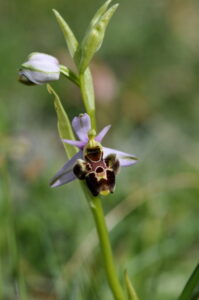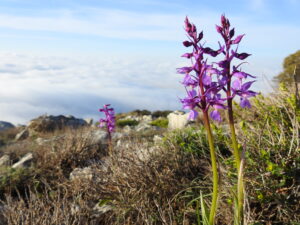A new protocol for orchids at Courmettes
In 2010, of the 160 species of orchids identified in mainland France, 27 were threatened with extinction, and 36 were in the process of becoming so.* On the Domaine des Courmettes, a Natura 2000 site managed by A Rocha, 34 species have been identified, 11 of which are classified as protected species in the PACA region. At the beginning of 2022, our team decided to set up a test protocol for monitoring the orchids to protect them from potential threats and to monitor the ecological status of the site.
Orchids: flowers that are sensitive to changes in their ecosystem

© Nicolas Zwellen
There are between 19,000 and 24,000 species of orchids in the world, whose interactions with their environment vary greatly depending on the species. Their annual growth cycle is highly dependent on the temperature of their ecosystem. For example, tuberous orchids only flower after a state of ‘dormancy’, which occurs when temperatures drop during the winter. Similarly, in places with very hot summers, when water resources are very limited, the plant adapts and enters a ‘resting’ phase. The growth of most orchids also depends on their exposure to light, as flowering is directly linked to the photoperiod (day length). Thus, in the south of France, where the greatest diversity of orchids is found, the flowering phase is earlier and longer than in the north of the country.

© Nicolas Zwellen
Orchids are bio-indicator species: their presence and evolution reflect variations in environmental conditions, such as the disappearance of environments, overgrazing or climate change. The study of bio-indicator species therefore makes it possible to monitor the evolution of an ecosystem and its ecological state. In our case, the Domaine des Courmettes offers a mosaic of environments: wetlands, forests, grazed and/or mowed meadows, etc. This variety of environments and also of human activity (more, or less, intensive grazing, mowing or not) allows orchid species with different ecological needs to establish themselves. Monitoring these different species with different ecological requirements makes it possible to follow the evolution of the different environments.
Why are orchids disappearing in France?
For several decades now, scientists have observed** a significant decrease in the number of orchids in France. The causes of their gradual disappearance include
- The destruction of their habitats: many biotopes have fallen victim to urbanisation, intensive agriculture, or have been transformed into industrial zones
- Fertilisers, herbicides or phytosanitary products: these pollute soils and aquifers and orchids are very sensitive to disturbances in the rhizosphere (the area of the soil where the roots are)
- Marketing: the sale of orchids is a lucrative activity, especially for tropical species (although this does not concern France)
- Climate change: at the local level, average temperatures and rainfall intensity are modifying ecosystems
- The natural evolution of their habitat: vegetation dynamics indicate that open areas (sparsely vegetated) tend to close in, as they are overgrown by brambles, broom, etc., and at the same time the orchids disappear
Testing a monitoring protocol for the orchids of the Domaine des Courmettes

© David Nussbaumer
Since 2018, 34 orchid species have been recorded on the 600 ha of the Courmettes estate, 11 of which are classified as protected species in the PACA region. At the beginning of 2022, Coline Raillon, in charge of the nature side at Les Courmettes, and Alejandra, a European volunteer, set up a test study protocol on 12 areas with different types of habitats to :
- Analyse the effect of grazing on the reproduction of orchids
- Monitor the evolution of orchid populations in the areas studied
- Analyse the evolution of their habitats (disappearance of environments, overgrazing, climate change)
- Identify existing or potential threats to their survival
This first year will allow the protocol to be tested and modified if necessary and the data collected in 2022 will serve as a baseline. We intend to continue this monitoring over the long term in order to gain a better understanding of the evolution of the ecological state of the estate and to be able, if necessary, to implement actions to preserve the various environments.
* (IUCN France, 2009; IUCN France, 2015); ** (Bournérias & Prat, 2005)
